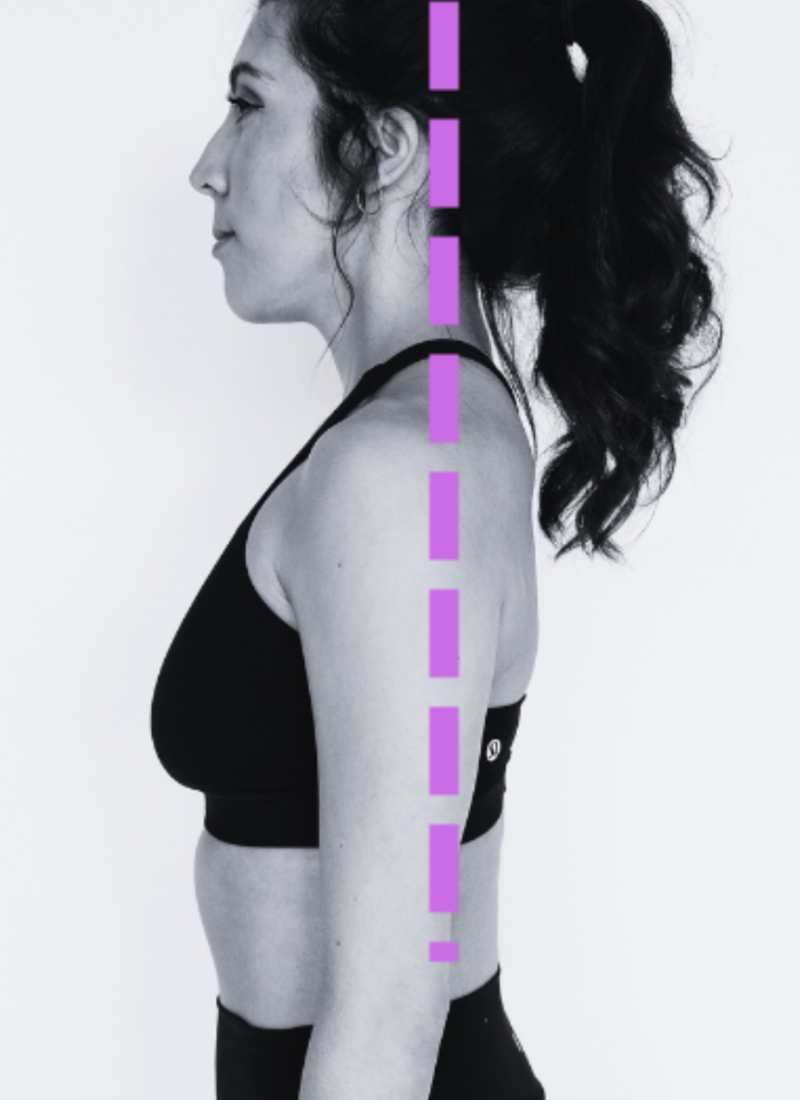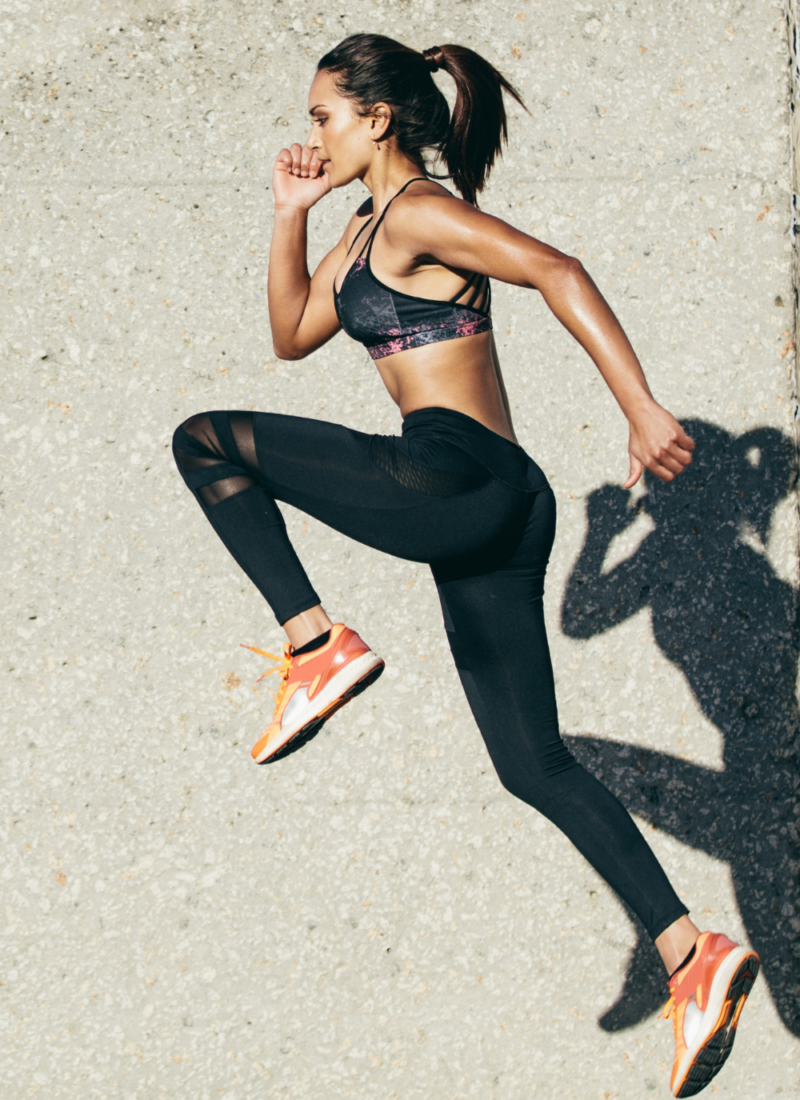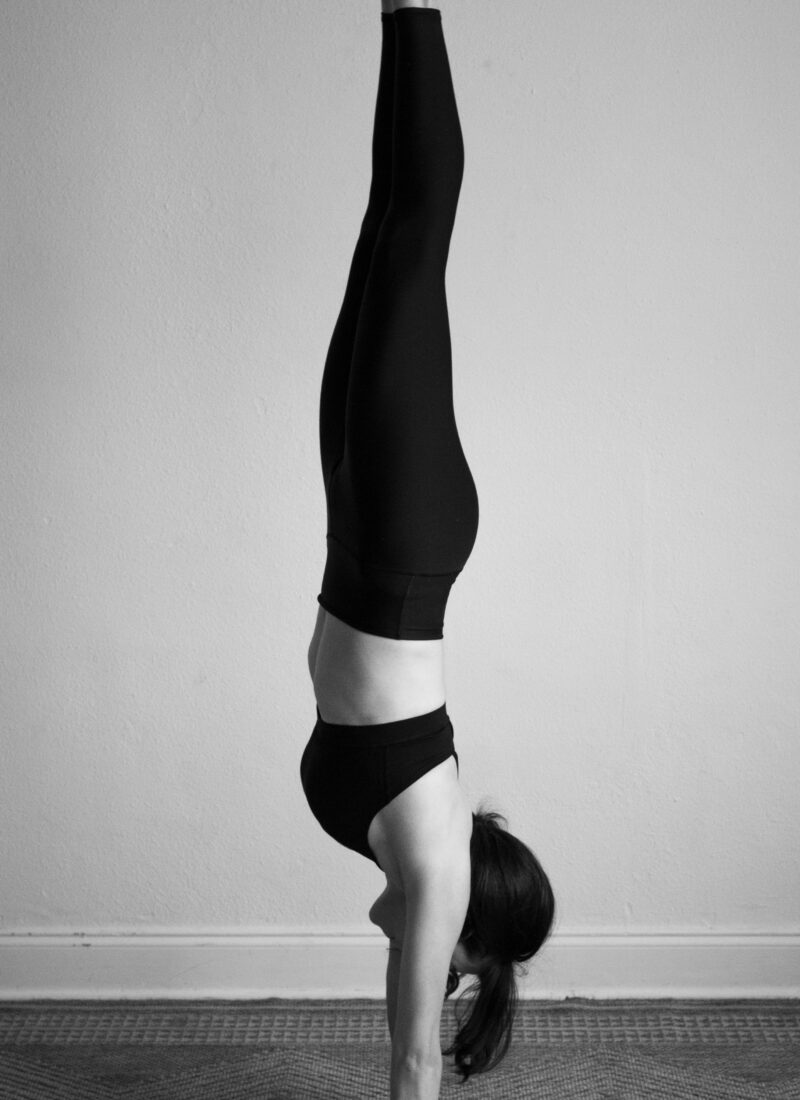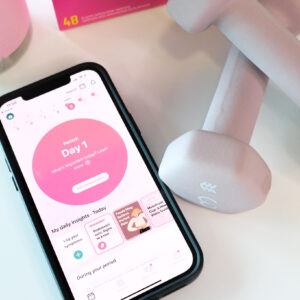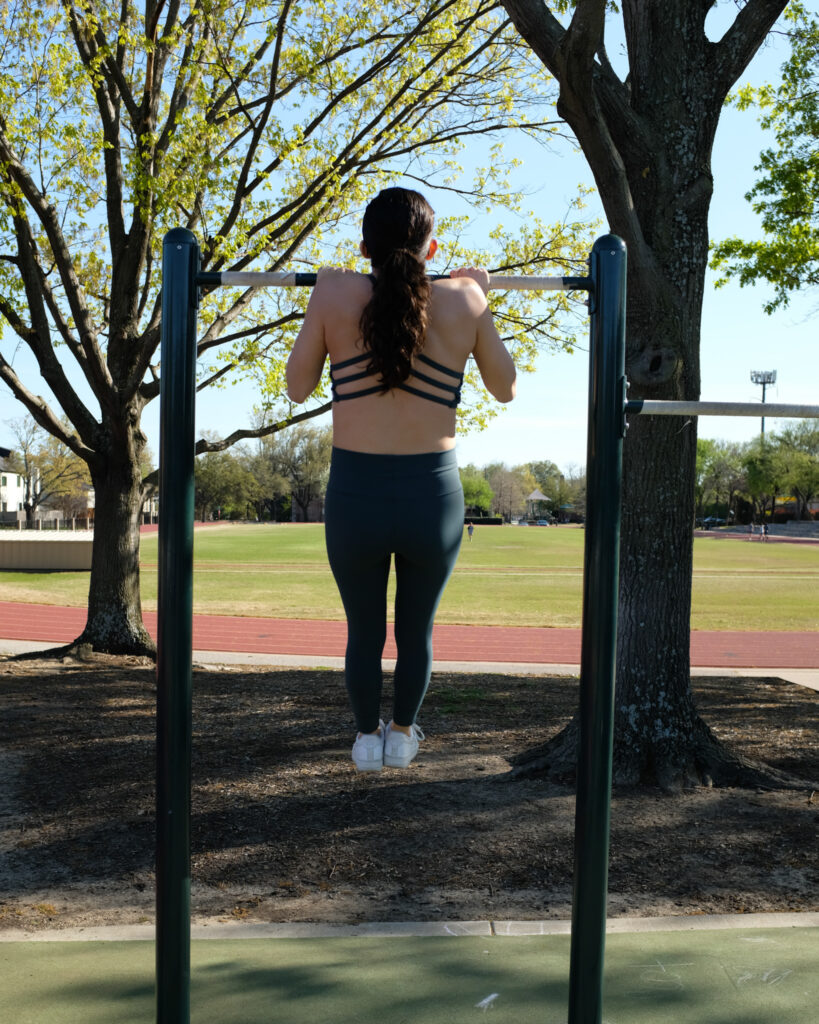
Want to know how to do pull-ups as a woman? The pull-up has been a unit to measure physical fitness among the likes of school P.E. teachers and Marine drill instructors. Even still, mastering the pull-up is a physical feat that not many women can do. That’s why lots of fitness tests you may have encountered at school or elsewhere would allow us girls an alternative to pull-ups, such as the flexed arm hang or push-ups.
As a female who can be a little too competitive at times, I trained pull-ups to prove to myself and others that I can do anything I set my mind to. After consistent training for a few years, I can not only do a pull-up, but I can do multiple.
All that isn’t to brag, but it is to say that if I can do it, so can you.
In this article, I will show you all the exercises I incorporated into my routine to master the awe-inspiring pull-up.
Alright, are you ready to start this challenge?
What you Need:
1. A Pull-Up Bar
Most gyms have a pull-up bar, and a lot even have an assisted pull-up machine. If you don’t have a gym membership, look for a public park with a bar you could use to practice pull ups, otherwise you can conveniently purchase an over-the-door-pull-up bar from Amazon or another online store. (This pull-up bar from Amazon fits most doors. I personally use the pull-up bar linked here.)
2. Resistance Bands
Many gyms have these for use, but you can easily order some from Amazon if you need. These bands are used to assist you with the pull up and can be purchased from Amazon here.
What Is a Pull-Up
Pull-ups are performed by hanging from the bar with an overhand grip, then using your upper body strength to bring your chin to just above the level of the bar, followed by controlled movement back to the starting position. These are not to be confused with chin-ups which use an underhand grip.
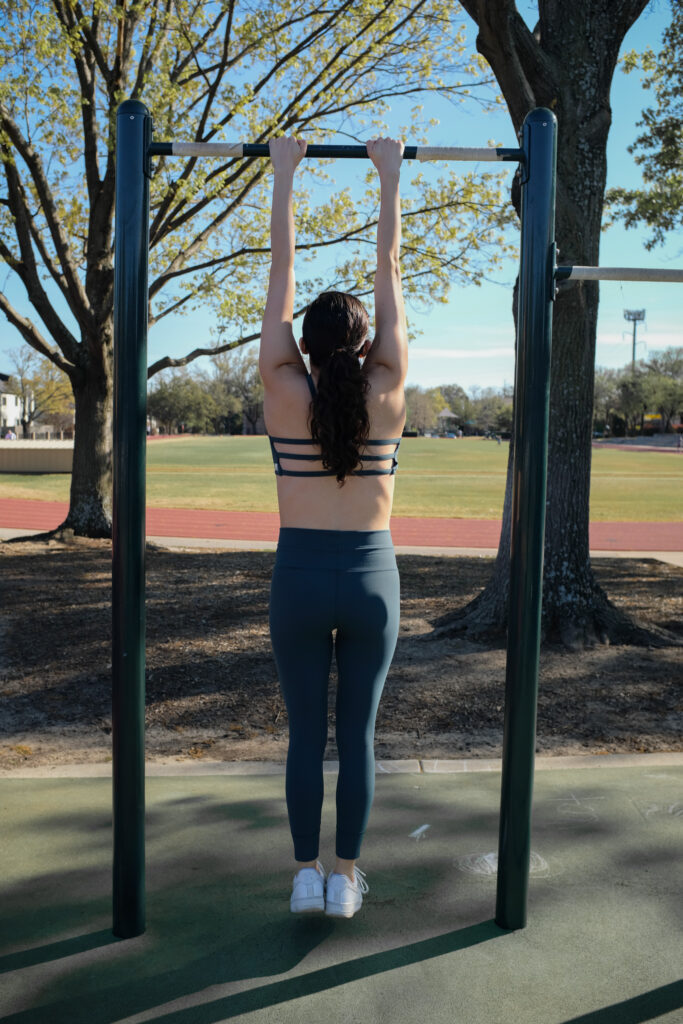
Can Women Do Pull-Ups?
In short, yes women can absolutely do pull-ups! So why is this a question? Well, the pull-up has long been known as a challenge for even the most fit women.
In fact, the U.S. Marines physical fitness test requires males aged 26-30 to do 11 pull-ups for the same score as females of the same age group who do 3 pull-ups. So, why is that?
There are many factors that contribute to a pull-up. Some of these factors cannot be changed such as height and build. Generally speaking, people who are taller and bigger struggle with pull-ups more than people who are of lower body fat and shorter stature. In fact, one study found that when one’s body mass was increased by 10%, pull-ups performance decreased by 53%, suggesting that greater body size makes doing a pull-up more difficult and therefore it is not the most fair measure of muscular endurance.
Not to mention, having longer arms is not your friend when it comes to pull-ups since you have a longer distance to lift your body weight. That is why a lanky volleyball player might not be able to do a pull-up even if she is fit.
Additionally, women usually carry at least 10% body fat and men can more easily reduce body fat to 4%, on average. Plus women have 40% less upper body mass than men according to a study, which can lead to an average of 50% to 60% less strength than an average male.
More fat and less upper body strength make it difficult for anybody, regardless of biological sex, to lift their entire body weight from a dead hang. However, don’t let that be a deterrent in your pull-up training. If anything, for me it is motivation to train pull-ups.
The bottom line is, even if it is more difficult for most females to do pull-ups, it doesn’t mean we are incapable. In fact, there are so many benefits to training the upper body to do pull-ups. Even the most novice exercises have many benefits mentioned below.
Why Women Should Train for Pull Ups
Besides the fact that you might need to pull yourself up from the side of a cliff like in the movies (am I wrong?), pull-ups training is great for building upper body strength and improving posture. It helps with upper body mobility, core stability, and grip strength. Not to mention, it’s badass.
Of note, performing a pull-up is not necessarily the best barometer to measure fitness. For reasons mentioned above, there are many factors that can make the pull-up a challenge for even some of the most fit athletes. But it is a cool, hard-core skill that will make you feel like Wonder Woman. If you don’t get the pull-up right away, training the pull-up will build up strength in your latissimus dorsi, deltoids, trapezius, rhomboids, biceps, triceps, forearms, and core.
Further, resistance training in general promotes bone mineral density. This is great, especially for women, in the long run as it decreases your risk of developing osteoporosis later in life.
How to Get Your First Pull-Up
- Complete the following exercises every two to three days so your arms can recover.
- Once you master one of the progressions, you can start training the next one.
- Most importantly, be consistent and don’t give up.
How Many Weeks Does It Take To Get Your First Pull-Up
Depending on your body weight and grip strength from the jump, it takes 4 to 12 weeks for most to get their first pull-up.
Don’t get discouraged, stay consistent, and you will see results.
Progression for Pull-Ups
1. Dead Hang
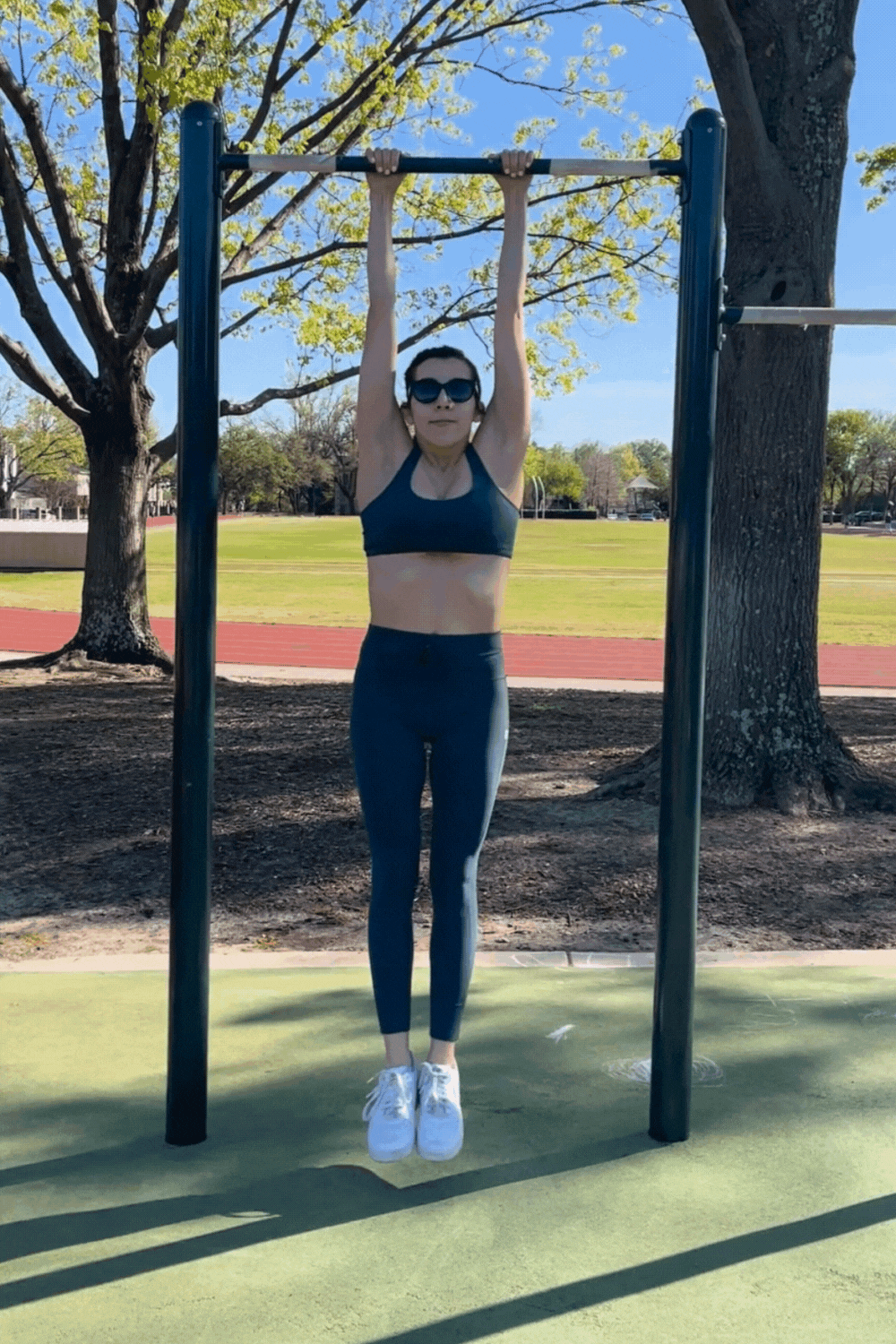
Trains grip strength, core stability, helps with spinal decompression
- Grab onto the pull-up bar with both hands and let your body hang.
- Think about keeping your entire body tense.
- Hold for 30 seconds if you can. Rest for at least 60 seconds then repeat. Do this 5 times.
Tips:
- If this is too advanced for you, hold heavy dumbbells in your hands at your sides just to build grip strength.
- On the other hand, if this is too easy, try adding extra weight such as ankle weights or try it with a bigger bar.
2. Scapular Pull-Ups
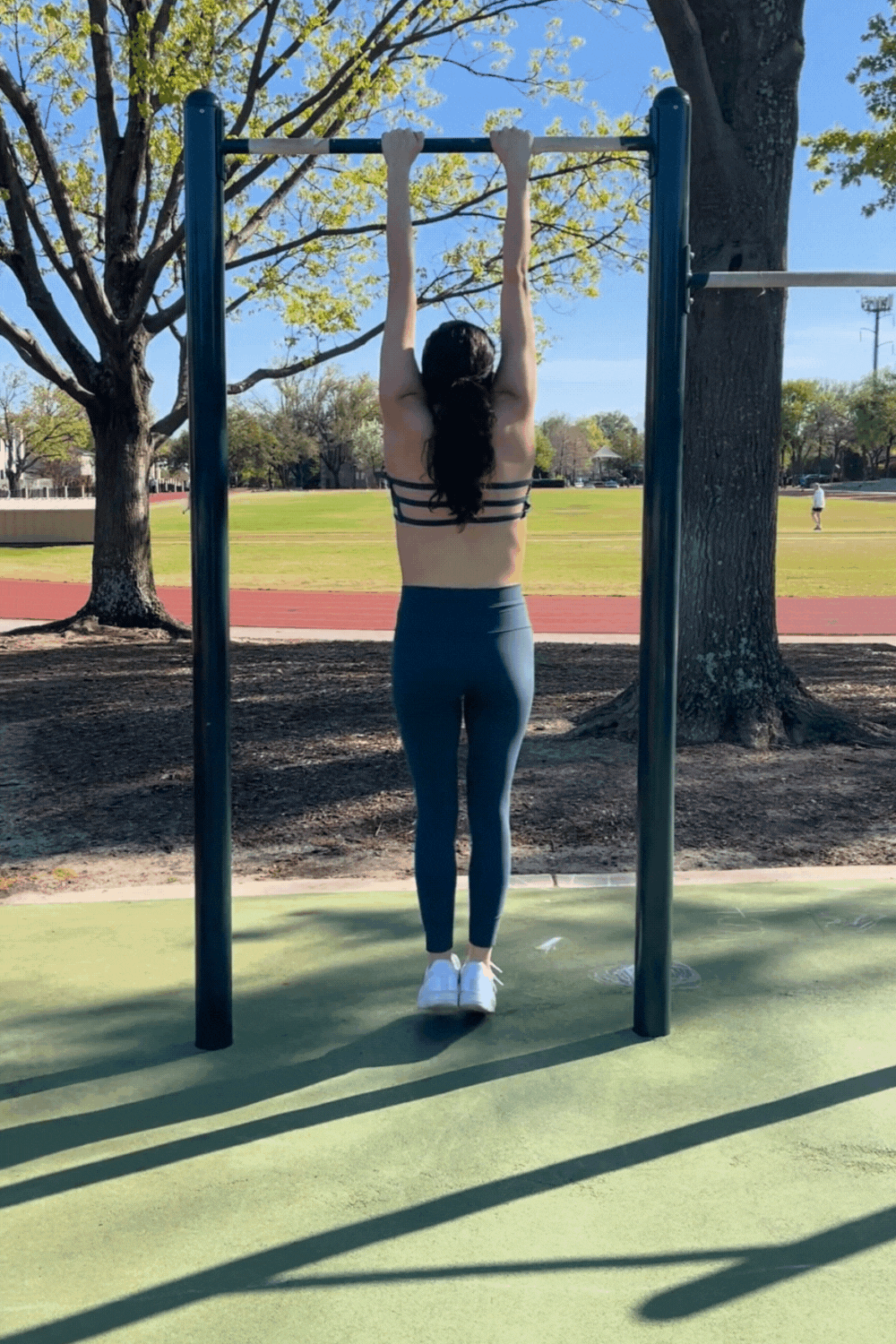
Trains grip strength, trapezius, and latissimus
- Start in a dead hang with an overhand grip on the bar.
- While keeping your body tense, flex your shoulders and think about doing a reverse shrug.
- Hold the position for one second then return to the starting position.
- Try to do 10 reps.
3. Optional – Inverted Rows
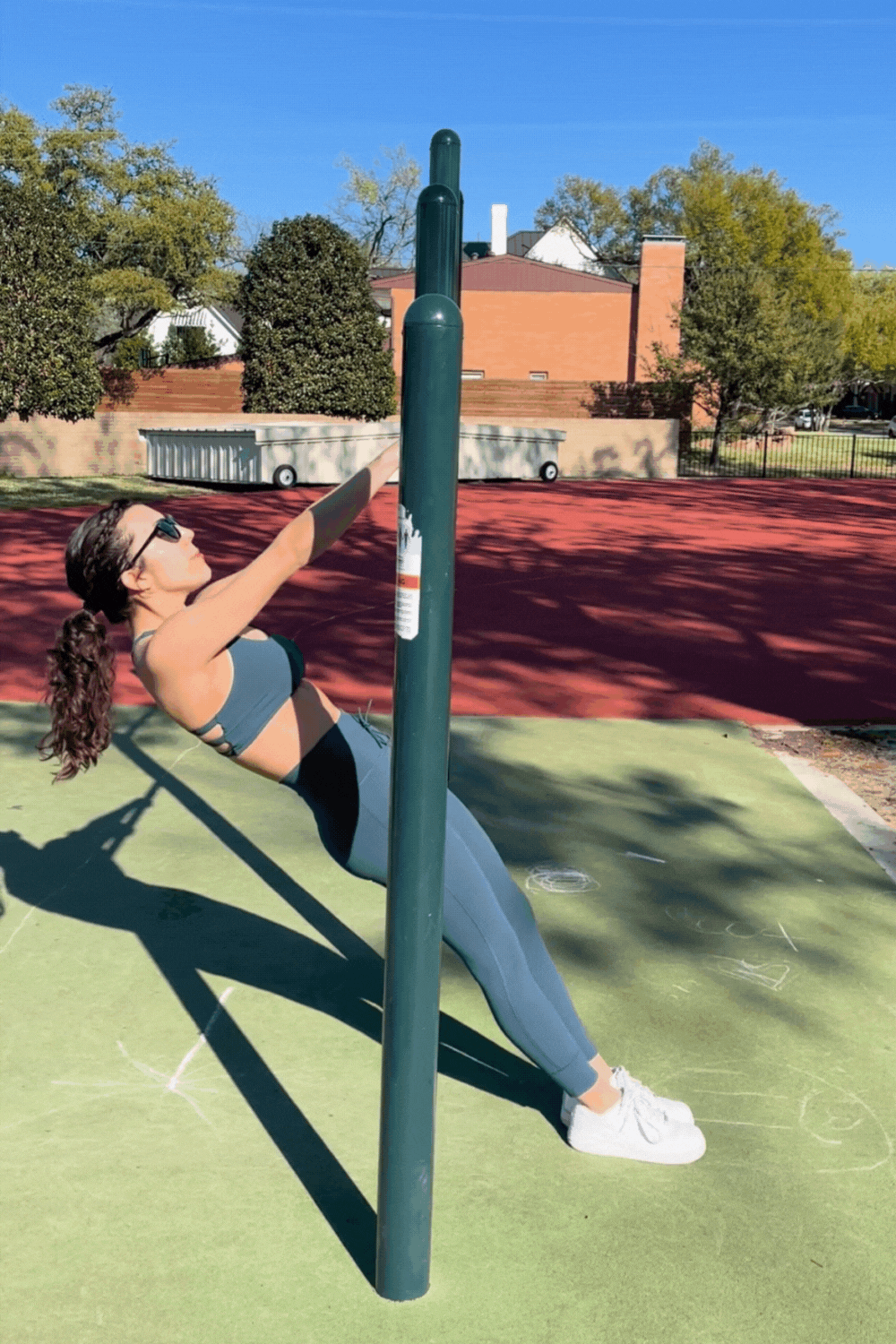
*This requires an adjustable or a low bar
Trains back muscles, biceps, forearms, grip
- If you’re using an adjustable bar, change the height of your bar to anywhere between your waist and chest.
- Position yourself face-up and grab the bar with an overhand grip.
- While keeping your abs, legs, and butt tight, pull yourself up so your chest touches the bar.
- Lower yourself down to the starting position.
4. Flexed Arm Hang
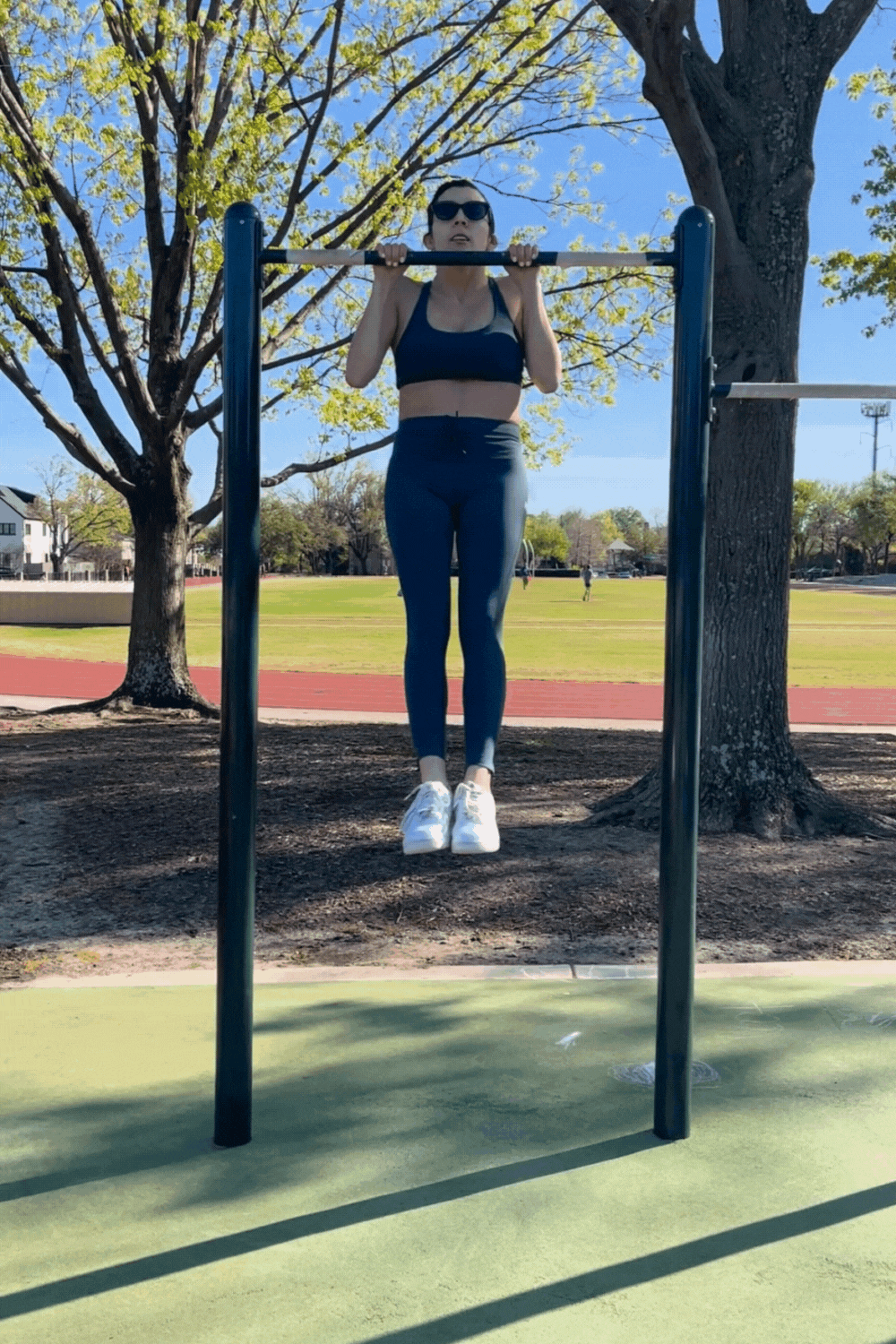
Trains biceps, forearms, and back
- Grip the bar with an overhand grip and get your chin above the bar. You may need to jump to the pull-up position or use a bench/partner to assist you.
- Without any support, try to hold your chin above the bar for as long as possible.
5. Negatives
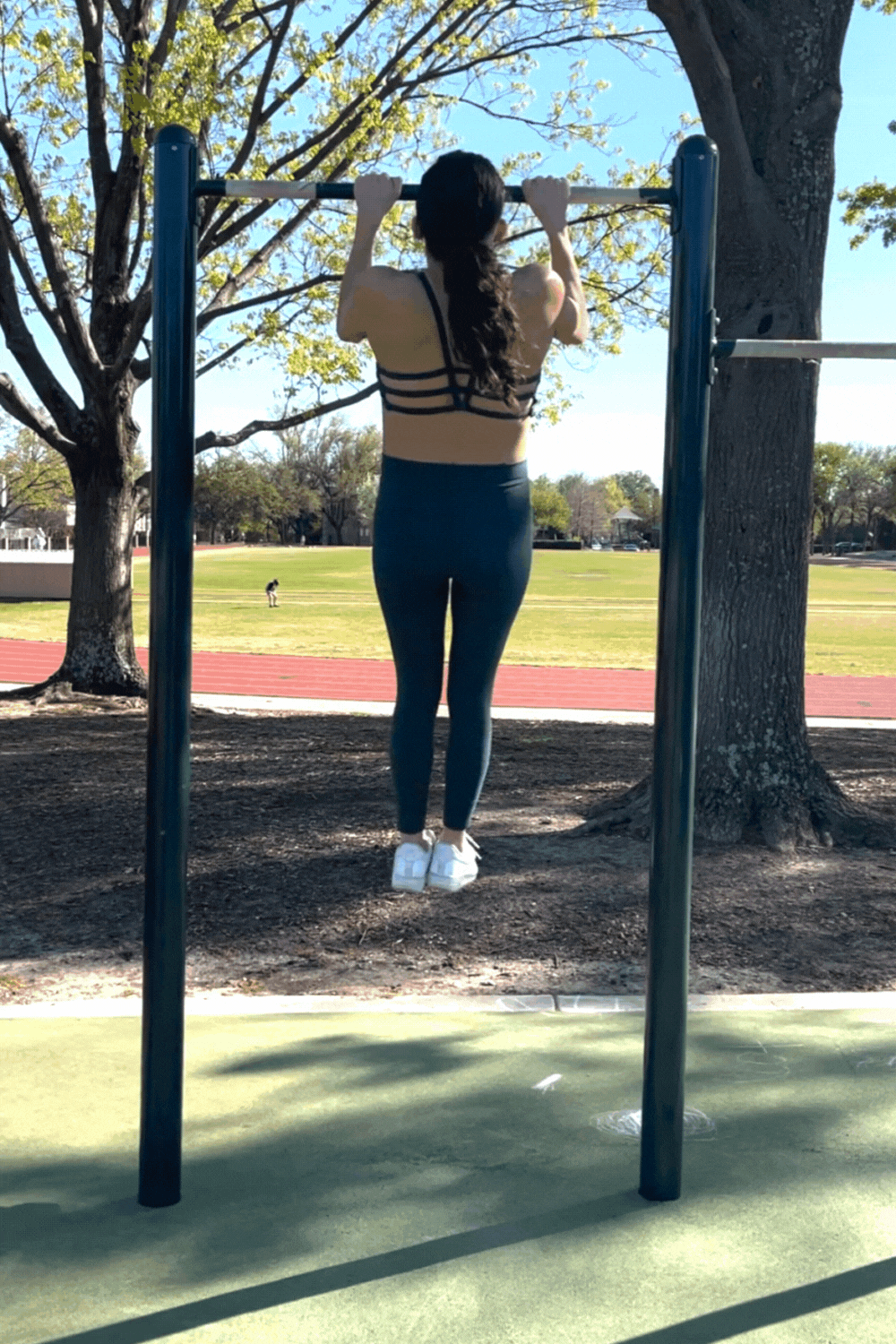
Trains biceps, forearms, and back
- Grip the bar with an overhand grip and get your chin above the bar. You may need to jump to the pull-up position or use a bench/partner to assist you.
- As slowly and controlled as possible, lower yourself to a dead hang. Try not to simply let your body drop.
- You may only be able to do one or two at first. Over time, attempt to do four or five repetitions.
Tips:
- If this is too advanced for you, try using a resistance band to assist you.
6. Band Assisted Pull-Ups
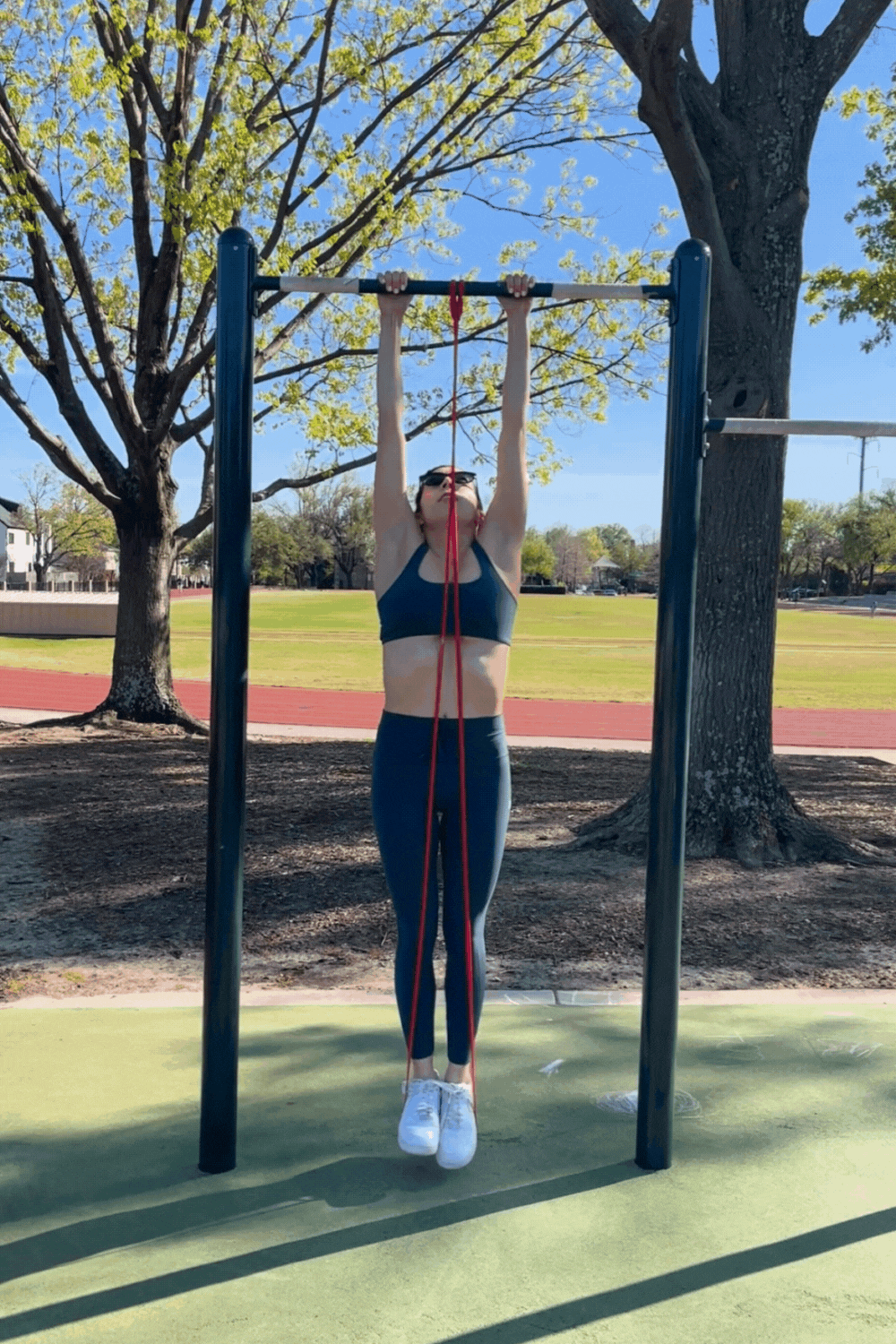
Trains biceps, forearms, and back
- Grab your resistance band and loop it around the pull-up bar.
- With an overhand grip on the bar, support your feet on the band and pull your chin above the bar.
- Lower yourself to a dead hang.
Tips:
- Start with the strongest resistance band you have. If this is too advanced for you, try using two resistance bands or as many as you need to pull yourself up.
- As you get stronger, use a thinner resistance band that will not give you as much assistance.
- You can purchase resistance bands here.
7. Go For Your First Pull-Up!
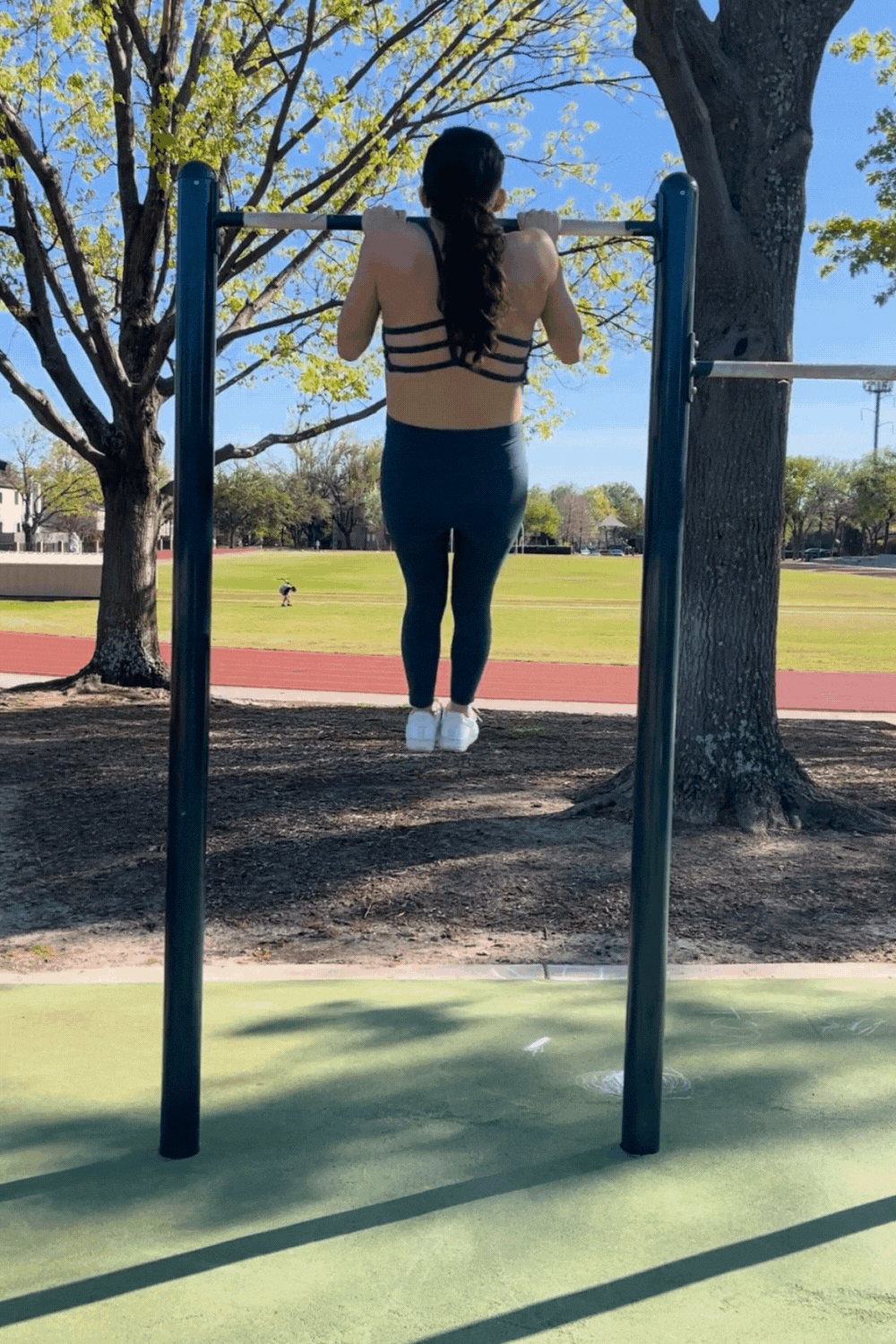
Trains biceps, forearms, and back
- Grab onto the pull-up bar with both hands and let your body hang.
- Think about keeping your entire body tense.
- Pull your chin above the bar and lower yourself down to the starting position.
Tips
These moves are very exhausting, so don’t overdo it by doing these moves over and over again. Focus on doing them every two to three days and only a few reps at a time until you master each progression of the pull-up with good form.
Can’t You Just Train Lat Pull Downs at the Gym to Help Pull-Ups?
A lot of people believe that training lat pull-downs at the gym correlates with one’s ability to perform a pull-up, but not so fast. One study suggests that these two exercises are not to be analogous with one another.
This study looked at college-aged female athletes, and found that there is a more significant correlation between one’s body mass and the ability to do a pull-up than a correlation between lat pull-downs and pull-ups.
Essentially, body composition plays a significant role in doing pull-ups for both men and women. If someone has greater body mass in the shoulders as opposed to the thighs, for example, the likelihood of them doing a pull-up goes up.
The benefits to building strength via lat pull-downs aren’t to be belittled, however. If you enjoy that exercise, then do it. I mention this study just so you know that lat pull-downs alone may not help you achieve the pull-up.
The Bottom Line
Think women can’t do pull-ups? Well think again. With consistent training, anyone can do pull-ups. Albeit, everyone’s bodies are different and therefore some people will have an easier time lifting their body weight than others. However, I believe anyone in good health is capable of building the strength to get their first pull-up.
That being said, don’t compare yourself to others if you haven’t gotten your first pull-up yet. Our bodies are like levers so long, lanky people might struggle more than petitie people do when it comes to lifting their entire body weight from a dead hang. Pull-ups are not necessarily the end-all-be-all of fitness.
Regardless of where you are in your pull-ups journey, these exercises are great for everyone as they help build strength and improve bone density.
This Article Was All About How to Do Pull-Ups As a Woman
At the end of the day, it’s about the journey we’re on while approaching our goals. Fitness training, to me, is mostly about overcoming a challenge, and I take that attitude with me through life. My recommendation is to focus on consistent training over mastering the new skill as quickly as possible, which can lead to frustration if you are not advancing as rapidly as you think you should. You’ll be surprised how shifting your mindset to prioritize consistency will catalyst your results, and make you feel successful on your endeavor to your first pull-up!

